
Tuolumne Meadows is a gentle, dome-studded, sub-alpine meadow area along the Tuolumne River in the eastern section of Yosemite National Park in the United States. Its approximate location is 37°52.5′N119°21′W. Its approximate elevation is 8,619 feet (2,627 m). The term Tuolumne Meadows is also often used to describe a large portion of the Yosemite high country around the meadows, especially in context of rock climbing.
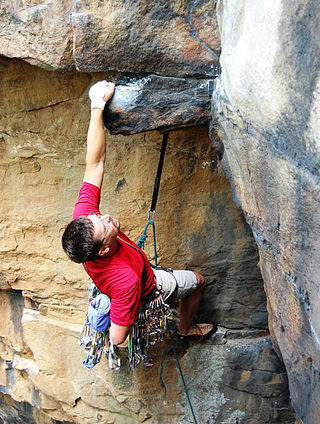
Traditional climbing is a type of free climbing in rock climbing where the lead climber places the protection equipment while ascending the route; when the lead climber has completed the route, the second climber then removes the protection equipment as they climb the route. Traditional climbing differs from sport climbing where the protection equipment is pre-drilled into the rock in the form of bolts.

A climbing route is a path by which a climber reaches the top of a mountain, or rock/ice-covered obstacle. The details of a climbing route are recorded in a climbing guidebook and/or in an online climbing route database, and will include elements such as the type of climbing route, the difficulty grade of the route–and beta on its crux(es)–and any risk or commitment grade, the length and number of pitches of the route, and the climbing equipment needed to complete the route.
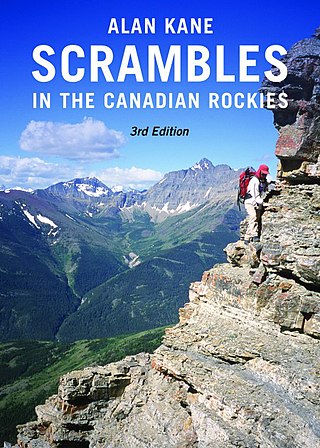
Climbing guidebooks are used by mountaineers, alpinists, ice climbers, and rock climbers to locate, grade, and navigate climbing routes on mountains, climbing crags, or bouldering areas. Modern route guidebooks include detailed information on each climbing route, including topo diagrams, route beta, protection requirements, and the ethics and style that are in place for a given climbing area.

Frog Buttress is a cliff on the north-west side of Mount French, in the Moogerah Peaks National Park near the town of Boonah in Queensland, Australia. It became famous when local rock climbers Rick White and Chris Meadows discovered it in 1968. Since then, 400 routes have been established by climbers including Henry Barber, Kim Carrigan and Tobin Sorenson.

Rock climbing is a sport in which participants climb up, across, or down natural rock formations or indoor climbing walls. The goal is to reach the summit of a formation or the endpoint of a usually pre-defined route without falling. Rock climbing is a physically and mentally demanding sport, one that often tests a climber's strength, endurance, agility and balance along with mental control. Knowledge of proper climbing techniques and the use of specialized climbing equipment is crucial for the safe completion of routes.

Little Cottonwood Canyon lies within the Wasatch-Cache National Forest along the eastern side of the Salt Lake Valley, roughly 15 miles from Salt Lake City, Utah. The canyon is part of Granite, a CDP and "Community Council" designated by Salt Lake County. The canyon is a glacial trough, carved by an alpine glacier during the last ice age, 15,000 to 25,000 years ago. A number of rare and endemic plant species are found in the canyon's Albion Basin. Introduced Mountain goats inhabit the surrounding mountains.
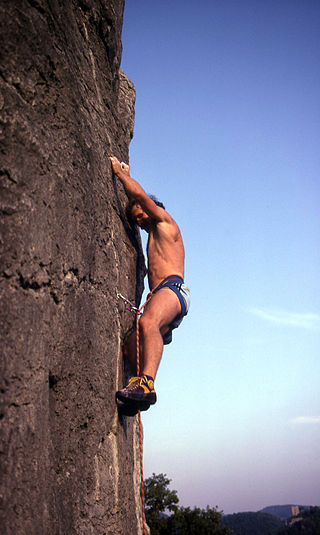
In rock climbing, redpointing means to free-climb a route from the ground to the top while lead climbing, after having practiced the route or after having failed first attempt. Climbers will try to redpoint a route after having failed to onsight it, or flash it. The first successful redpoint of a route, in the absence of any prior onsight or flash, is recorded as the first free ascent (FFA) of that route.

Royal Robbins was one of the pioneers of American rock climbing. After learning to climb at Tahquitz Rock, he went on to make first ascents of many big wall routes in Yosemite. As an early proponent of boltless, pitonless clean climbing, he, along with Yvon Chouinard, was instrumental in changing the climbing culture of the late 1960s and early 1970s by encouraging the use and preservation of the natural features of the rock. He went on to become a well-known kayaker.

Mount Arapiles is a rock formation that rises about 140 metres (460 ft) above the Wimmera plains in western Victoria, Australia. It is located in Arapiles approximately 10 kilometres (6.2 mi) west of the town of Natimuk and is part of the Mount Arapiles-Tooan State Park. Arapiles is a very popular destination for rock climbers due to the quantity and quality of climbs. It is one of the premier climbing sites in Australia along with the nearby Grampians. The Wotjobaluk name for the formation is Djurid.

Beta is a climbing term that designates information about how to ascend a climbing route, and the specific climbing techniques required—and how to apply them—to overcome the key challenges encountered. Traditionally sourced in climbing guidebooks, online databases and apps now provide detailed climbing beta. The term is attributed to Texan climber Jack Mileski.

North Palisade is the third-highest mountain in the Sierra Nevada range of California, and one of the state's small number of peaks over 14,000 feet, known as fourteeners. It is the highest peak of the Palisades group of peaks in the central part of the Sierra range. It sports a small glacier and several highly prized rock climbing routes on its northeast side.

Ron Kauk is an American rock climber. Kauk is associated with Camp 4 in Yosemite Valley, where he lived for decades, now a resident of El Portal, California.

Charlie Fowler was an American mountain climber, writer, and photographer. He was one of North America's most experienced mountain climbers, and successfully climbed many of the world's highest peaks. Along with his climbing partner, Christine Boskoff, he went missing in southwestern China sometime between November 11 and November 14, 2006. His body was found on a Ge'nyen Mountain on December 27, 2006, and was officially identified a day later.

Thomas John Higgins was an American rock climber with many first and first free ascents primarily in the western United States. He was noted for pushing standards using a purist, free climbing style.
John Ewbank was an English-born Australian rockclimber. He was born in Yorkshire, England in 1948, but emigrated to Australia at the age of 15. He is best known for his development of the Ewbank System, used in Australia, New Zealand, and South Africa for grading climbs.
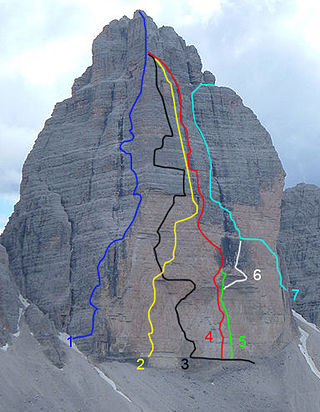
In climbing, a topo is a graphical representation of a climbing route. Topos range from a photograph of the climb on which the line of the route is overlaid, to a detailed diagram of the key features and challenges of the climb.

Mount Piddington is a mountain in the Explorer Range of the Blue Mountains region, located south of the village of Mount Victoria in New South Wales, Australia.

Geoff Weigand is an Australian rock climber and road cyclist.
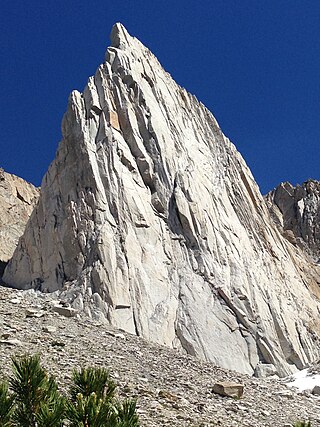
The Incredible Hulk, or Incredible Hulk, is a granitic summit with an elevation of 11,300 feet (3,444 m) located in the Sierra Nevada mountain range, in Mono County of northern California, United States. The summit is set in Little Slide Canyon of the Hoover Wilderness, on land managed by Humboldt–Toiyabe National Forest, and is one mile outside the boundary of Yosemite National Park. The peak is situated approximately three miles southwest of Twin Lakes, three-quarters mile east of Kettle Peak, and 2.5 miles northwest of Matterhorn Peak. The nearest town is Bridgeport, 14 miles to the northeast. Topographic relief is significant as the summit rises 3,700 feet above Robinson Creek in one mile (1.6 km). Incredible Hulk is the unofficial name of this landform, and will remain unofficial as long as the USGS policy of not adopting new toponyms in designated wilderness areas remains in effect.


















